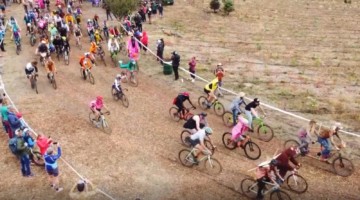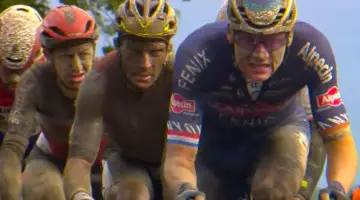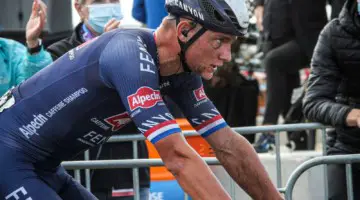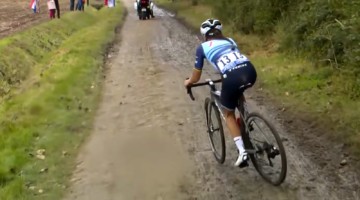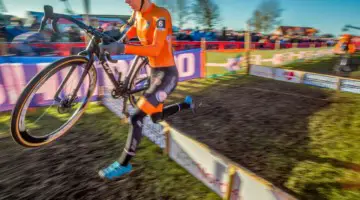This Sunday, April the 14th, is a day where cycling fans are looking forward to for a long time.
With Paris-Roubaix, it’s time for the last of this year’s cobblestone classics, but also the most important one. Paris-Roubaix is the third monument of the year and the grandest of the series of five races that started with Milan – San Remo.
Paris-Roubaix simply is “La Reine des Classiques” (The Queen of the Classics).
In this preview, we’ll provide our readers with a little history of the race and with information about this year’s course.
A Little History
The first Paris-Roubaix took place in 1896. The fact that Paris-Roubaix is also called “The Hell of the North” has something to do with the First World War.
In the 1919 edition of Paris-Roubaix, which was the first edition after the war, a journalist, who reported on the race, used the name “The Hell of the North” because he was stunned because of all the war destruction he saw in Northern France, where the race is held.
🇬🇧 A century ago, the Armsitice.
Paris-Roubaix history was marked by WWI firstly because of its enigmatic nickname « Hell of the North » from the stories of Eugène Christophe and the Morning Post describing the course scarred by the conflict.
1/2#ParisRoubaix pic.twitter.com/OcS9rB2D4G
— Les Amis de Paris-Roubaix (@A_ParisRoubaix) November 11, 2018
Paris-Roubaix is the monument with the longest history.
This year’s edition will be edition 117. Except for some years during the two World Wars, Paris-Roubaix has been organized every year since 1896. The first edition in 1896 was won by German rider Josef Fischer.
Up until 2015, Fischer was the only German winner of Paris-Roubaix. In that 2015 edition, John Degenkol (Trek-Segafredo) took the title of last German winner. In a sprint of seven riders, he took the win before Zdenek Stybar (Deceuninck – Quick-Step) and Greg Van Avermaet (CCC Team).
For Stybar, 2015 was his first of two second places in Paris-Roubaix. In 2017 he finished second again after being defeated in the sprint for first by Greg Van Avermaet, who is the last Belgian winner of the race.
In the 2016 edition, Australian rider Mathew Hayman withheld Tom Boonen from becoming the sole record holder with five wins.
Boonen, who became co-record-holder with Roger De Vlaeminck in 2012 (both riders have 4 wins), on paper was the fastest out of 5 riders who went towards the sprint in that 2016 edition. Hayman, who had been in the breakaway that day, had more energy left though and defeated Boonen.
Because of that, Roger De Vlaeminck, who never finished outside the top 10 in Roubaix, stays “Monsieur Paris-Roubaix.” In 1975 De Vlaeminck withheld cycling legend Eddy Merckx from winning Paris-Roubaix 4 times by defeating Merckx in the sprint.
Just as Merckx, who won in 1968, 1970 and 1973, 6 other riders won Paris-Roubaix 3 times: French rider Octave Lapize (1909, 1910, 1911), Italian rider Francesco Moser (1978, 1979, 1980), Swiss rider Fabian Cancellara (2006, 2010, 2013) and Belgian riders Gaston Rebry (1931, 1934, 1935), Rik Van Looy (1961, 1962, 1965) and Johan Museeuw (1996, 2000, 2002).
Co-record-holder Roger De Vlaeminck won in 1972, 1974, 1975 and 1977. The other co-record holder Tom Boonen won in 2005, 2008, 2009 and 2012.
Ten riders have succeeded in what they in cycling call “De Dubbel.” A rider who succeeded in “De Dubbel” won the two cobblestone monuments (Ronde van Vlaanderen and Paris-Roubaix) in the same year.
Eight riders succeeded in “De Dubbel” once: Swiss rider Heiri Suter (1923) and Belgian riders Romain Gijssels (1932), Gaston Rebry (1934), Raymond Impanis (1954), Fred De Bruyne (1957), Rik Van Looy (1962), Roger De Vlaeminck (1977) and Peter Van Petegem (2003).
Only 2 riders succeeded in “De Dubbel” twice: Tom Boonen (2005 and 2012) and Fabian Cancellara (2010 and 2013).
In the current peloton, no rider who succeeded in “De Dubbel” is active anymore. Only two riders in the current peloton won both the Ronde van Vlaanderen and Paris-Roubaix.
Dutch rider Niki Terpstra (Direct – Energie) is one of them. He won Paris-Roubaix in 2014 and the Ronde in 2018. After his crash in last week’s Ronde van Vlaanderen, Terpstra isn’t participating in this year’s edition of the Hell of the North.
The other rider who won both the Ronde and Paris-Roubaix is Peter Sagan (Bora – Hansgrohe). The Slovakian three-time World Champion won the Ronde in 2016 and won last year’s edition of Paris-Roubaix.
In that 2018 edition he escaped from the group of favorites, joined some riders of the early breakaway and defeated one of them, Swiss rider Silvan Dillier (AG2R La Mondiale), in the sprint.
With his 2018 win, Sagan was the first reigning world champion to win the race since Bernard Hinault in 1981.
#ICYMI And a rainbow appeared in the dust. 🌈🏆 #ParisRoubaix pic.twitter.com/n3vnUQKZbg
— Paris-Roubaix (@Paris_Roubaix) April 8, 2018
Unfortunately, Paris-Roubaix 2018 is also known for the death of Belgian rider Michael Goolaerts, who died because of heart failure during the race. Sector 28 of this year’s Paris-Roubaix, the sector from Briastre to Viesly, is from now on the “Secteur pavé Michael Goolaerts” as a tribute the Belgian rider.
Sector 2️⃣8️⃣, from Briastre to Viesly, secteur Michael Goolaerts as a tribute to the belgian rider.
Le secteur 2️⃣8️⃣, de Briastre à Viesly, renommé secteur Michael Goolaerts en hommage au coureur belge. #ParisRoubaix pic.twitter.com/K5F3qsnrED
— Paris-Roubaix (@Paris_Roubaix) April 9, 2019
Goolaerts was a teammate of Wout van Aert (Jumbo – Visma), and last year, the Belgian star rode with #allforgoolie on the top tube of his Stevens Super Prestige
This Year’s Course
The first editions of Paris-Roubaix actually started in Paris, but due to the big distance between Paris and Roubaix, Compiègne is the city where the race has started since 1968. This year as well the start is in Compiègne.
Between Compiègne and Roubaix the riders will conquer 257 km this year. Over 54 kilometers have cobblestones spread over 29 cobblestone sections.
All 29 cobblestone sections are rated with a star system. The most difficult cobblestone sections get five stars. This year, there are three cobble sections with five stars.
After 164.5 km of racing, Le Trouée d’Arenberg is the first five-star section.
🎬 Renovated but still daunting! 😈
🎬 Rénovée mais toujours terrible ! 😈#ParisRoubaix pic.twitter.com/Vno3ap94e7
— Paris-Roubaix (@Paris_Roubaix) April 9, 2019
Mons-en-Pévèle is the second one after 212 km and Carrefour de l’Arbre is the third one after 242.5 km.
When you see this, you know the ordeal is *nearly* over! 💪
It’s the Carrefour de l’Arbre !🤩
Quand on voit ça, on sait que le calvaire est *presque* terminé ! 💪
C’est le Carrefour de l’Arbre ! 🤩#ParisRoubaix pic.twitter.com/MBJHtxyveU
— Paris-Roubaix (@Paris_Roubaix) April 9, 2019
After 97.5 km, cobblestone section 29 is the first cobblestone section of the race. Only two cobblestone sections have one star. The last cobblestone section with one star is cobble section one and is the last cobblestone section of the race. After that last cobblestone section, 1 km of racing is left.
Paris-Roubaix is also special not just because of the cobbles, but due to its finish, which is on a velodrome.
With 600m of racing left, the riders will enter the Vélodrome André Pétrieux in Roubaix, where they have to ride a lap and a half on the track. A sprint on a track is quite different from a regular sprint. It’s an advantage to have some track experience if you hit the velodrome with a group.
The last four editions of Paris-Roubaix have been decided in a sprint, suggesting every rider who rides Paris-Roubaix to win should probably go ride on a track at least once.
1 vélodrome, 1000 souvenirs. #ParisRoubaix 👉 J-24 pic.twitter.com/Naskp22a8o
— Les Amis de Paris-Roubaix (@A_ParisRoubaix) March 21, 2019
Even more important than your skills on a track are, of course, your skills on cobblestones. Depending on the weather conditions, the cobblestone sections in Paris-Roubaix are either dry and dusty or wet, muddy and slippery.
Thursday, Friday, Saturday and Sunday no rain is expected in Northern France, so this year’s edition will probably be dry and dusty, as it has been for much of the last two decades.
Despite Mathieu van der Poel tearing it up this spring, his Corendon-Circus team is not participating in this year’s Paris-Roubaix.
Although there probably won’t be any mud on Sunday, maybe cyclocross mud devil Wout Van Aert will be the reigning devil in Sunday’s Hell of the North? Will Stybar finally get his win at the Queen of the Classics?
The answer? Find it on Monday on our website.
The provisional start list is available here.
Featured image: john.john.59, used under a Creative Commons license.












